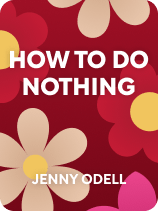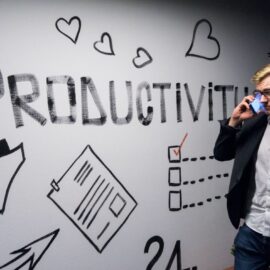

This article is an excerpt from the Shortform book guide to "How to Do Nothing" by Jenny Odell. Shortform has the world's best summaries and analyses of books you should be reading.
Like this article? Sign up for a free trial here.
Do you feel the need to be productive all the time? Do you feel guilty when you do nothing?
It’s easy to feel like you have to constantly be doing something. Social media declares that, to be a good person, you have to pay attention to the right post or cause; you feel like your time is money and you have to constantly use it productively. Jenny Odell says we must understand and resist this mindset.
Keep reading for an overview of Odell’s book How to Do Nothing: Resisting the Attention Economy.
Overview of How to Do Nothing: Resisting the Attention Economy
In modern life, the need to always do something can be overwhelming. You may feel as though you have to use all your available time to advance your career or accomplish something productive. In How to Do Nothing: Resisting the Attention Economy, professor and visual artist Jenny Odell argues that this feeling is created by broader social and economic forces and that devoting attention to “non-productive” things is a form of healing and social activism. Odell’s suggestion of “doing nothing” refers not to inaction but rather to actions that don’t have clear or immediate value, like sitting in nature, making art for its own sake, or learning about an abstract topic that interests you. We’ll explore Odell’s argument in three parts:
- Part 1: The Attention Economy explains why people feel a constant need to be productive and examines the impact of this feeling.
- Part 2: What It Means to Do Nothing outlines Odell’s critiques of other approaches to doing nothing and then introduces her method.
- Part 3: How to Do Nothing shows how Odell’s method of doing nothing benefits both individuals and society.
(Shortform note: How to Do Nothing is part of a growing trend of articles, books, and other media about finding joy and managing stress in an increasingly overwhelming modern world. For example, Austin Kleon’s Keep Going explores how to remain creative and find joy in creativity even while under stress. But while works like Kleon’s focus on the individual level, explaining how you can make your own life less stressful, How to Do Nothing tries to paint a broader picture—Odell explains why modern life, in general, is so stressful and outlines the social changes required to improve it. Odell still offers practical, everyday advice, but this isn’t the book’s only focus.)
Part 1: The Attention Economy
Before Odell discusses doing nothing, she first outlines the problems it’s meant to solve: the consequences of the attention economy, or the mindset of placing monetary value on time and attention. Part 1 explains how the attention economy works and explores its negative impacts.
How the Attention Economy Works
Odell explains that in the 1980s, corporate deregulation—the elimination of laws and rules regarding corporate conduct—as well as the loss of labor power allowed the wealthy and major corporations to monetize much larger portions of people’s lives. The cutting of social safety nets and stagnation of wages also put people in a situation where they couldn’t say no to more work or worse working conditions without risking their livelihoods. This economic shift led to a mindset shift: People had to start thinking of their time and attention in terms of monetary value.
The Monetization of Time
The increased monetization of time, Odell explains, means people are almost always “on” in some way. Over the past several decades, the line between when people are and are not working has grown blurrier. More jobs are temporary gigs or rely on self-promotion, meaning people have to use their time not only to do work but also to ensure they have more work to do in the future.
The Monetization of Attention
Odell suggests that the internet and social media have increasingly monetized attention. The internet generates more money than ever through pay-per-click ads, donations, sponsorships, and so on. And with the vast amount of information available on the internet, people have to compete to be noticed, and some use social or psychological manipulation to try and boost engagement. Even if you aren’t trying to garner attention of your own online, simply using the internet and social media means facing hordes of people clamoring for your attention, many of whom are manipulating you to try and boost engagement.
Consequences of the Attention Economy
Odell explains that the attention economy has two main consequences: loss of context and social atomization.
1) Loss of Context and Depth
Odell explains there’s no room for context and depth in the attention economy. Learning about the intentions and complexities behind an action, statement, or viewpoint requires a lot of time and probably won’t get very much attention. On the other hand, broader, shallower, and context-free actions, statements, and viewpoints take little time to produce and get a lot more attention.
Without context and depth, people are more easily misled and manipulated. They lack a full understanding of a given situation, and so they’re more likely to go with the most obvious or most popular interpretation, whether or not it’s actually true.
2) Social Atomization
The attention economy also leads to social atomization, or people becoming disconnected from one another and their communities, explains Odell. Since people are “always on,” they have less time to devote to nurturing connections with the people around them. In addition, succeeding in the attention economy requires people to constantly advocate for or “market” themselves through things like self-promotion or networking. This leads them to see each other as customers, or potential sources of monetary value, rather than as friends and community members.
Atomization has contributed in large part to the modern era’s epidemic of loneliness and lack of meaning in life, explains Odell. It also hampers social and political activism—when people lack deep connections with one another, it’s more difficult to organize them in pursuit of a specific goal.
Part 2: What It Means to Do Nothing
After explaining what the attention economy is and why it’s harmful, Odell discusses different methods people have used to try and resist it. In Part 2, we’ll discuss the methods she believes are flawed and then outline her method of doing nothing.
Wrong Ways to Resist
Odell critiques two conventional methods people have tried using to resist the attention economy: running away from society and doing a temporary “detox.”
1) Running Away From Society
The first form of resistance Odell critiques is leaving society entirely—going “off the grid” in some kind of isolated location or commune. This common fantasy of running away is impractical and self-defeating, argues Odell. Trying to live outside of and separate from our capitalist system is nearly impossible, as it requires total self-sufficiency.
Furthermore, running away from society won’t necessarily get rid of the attention economy mindset of viewing time and attention in terms of monetary value—you can still bring these deep-seated beliefs with you and apply them to your new community.
Lastly, Odell argues that any benefit of running away isn’t worth having to sever all connections with the people, environment, and history of your local community.
2) Doing a Temporary Detox
The second common understanding of doing nothing is as a temporary detox, or a break from the attention economy, explains Odell. This often takes the form of retreats where you “unplug” or getaways to remote locations without the internet or other common luxuries. Odell argues that the problem with this approach is that it fails to challenge the overall mindset behind the attention economy—viewing time and attention in terms of value and productivity. While retreats might help with stress or burnout at the moment, they don’t change the long-term habits that make people stressed and burned out in the first place.
The Right Way to Resist: Doing Nothing
Odell believes that, to resist the attention economy, you must do nothing. Doing nothing refers to two major mindset shifts:
- Refusing to engage with the attention economy
- Devoting time to connecting with the world around you
Essentially, doing nothing refers, not to inaction, but rather to devoting time and attention to things you care about that are hard for capitalism and the attention economy to monetize. Odell argues that doing nothing is an effective method of resistance because it actively refutes the mindset of the attention economy, instead of just trying to get away from the circumstances it creates. It also helps address both main consequences of the attention economy: reduced context and social atomization.
To illustrate how “doing nothing” can be a form of resistance, Odell references “Old Survivor,” the last old-growth coastal redwood tree in the Oakland, California area. In the 19th century, the timber industry—a capitalist institution—was cutting down all of the old, massive historic redwood trees in the area for lumber. However, Old Survivor was too small, inaccessible, and gnarled to be worth cutting down, so it was ignored and therefore lived on. In a sense, it resisted simply by doing nothing, and it lived on while all the trees that were “useful” to capitalist society died.
1) Resisting in the Right Way Adds Context and Depth
Doing nothing gives you a new appreciation for context and depth in your life, according to Odell. Under the attention economy mindset, activities that involve context and depth are “non-productive” because they lack monetary value. But by doing nothing, you’ll stop thinking of context and depth in this way and instead will appreciate how they can connect you to the world. This can apply on a personal level, with you finding more meaning in life through deeper engagement with the things you care about. It can also apply on a broader social level, with people taking the time to refine and contextualize the ideals of their social cause instead of relying on general outrage and discontent.
2) Resisting in the Right Way Prevents Social Atomization
Odell argues that doing nothing also helps prevent atomization. Once you escape the attention economy mindset, you’ll stop viewing others in terms of monetary value and will instead start viewing them as members of your community. With that perspective, you can connect with the world around you by forming genuine social bonds. This not only helps address personal loneliness and emptiness but also helps people band together to organize around social issues.
Part 3: How to Do Nothing
After explaining why doing nothing is the best way to resist the attention economy, Odell elaborates on how to do nothing. In Part 3, we’ll explore the two elements of Odell’s method:
- Changing how you use your attention
- Changing how you use your time
Change How You Use Your Attention
Doing nothing requires changing how you use attention, explains Odell. In particular, she emphasizes the importance of self-awareness—that is, noticing where you place your attention. Odell argues that you can take back control through self-awareness—by being aware of attention manipulation and value-based thinking.
1) Be Aware of Attention Manipulation
Odell explains that in the attention economy, people attempt to manipulate your attention through a number of different tricks—clickbait, addictive social media apps, flashy advertisements, and so on. Therefore, taking back control of your attention requires you to be aware of when your attention is being manipulated. Once you understand how people are trying to grab your attention, you can be more intentional in giving your attention to what you really care about, instead of to whatever is manipulating you.
2) Awareness of Value-Based Thinking
According to Odell, the attention economy mindset also creates strong thought patterns relating time and attention to value. For example, you might get frustrated with yourself when you feel like you’re not being productive, dismiss a task or activity because you see it as lacking practical value, or feel anxious whenever you aren’t working. She suggests you notice when you’re having these thoughts and directly challenge them, recognizing that they’re part of the harmful attention economy mindset.
Change How You Use Your Time
In addition to changing how you use your attention, Odell suggests changing how you use your time. Specifically, she argues you should devote time to familiarizing yourself with and connecting to the world around you. Odell offers three ways you can put your time to good use by connecting with the world around you: exploring your environment, learning about local history, and getting to know your neighbors.
Explore Your Environment
First, Odell advises you to do nothing by taking time to explore the natural environment. This adds depth and context to your life in two ways:
- When you learn about your natural environment, you see it in a deeper way—instead of just seeing “a bird” or “a plant,” you’ll recognize specific species and what makes them unique, interesting, and worth preserving.
- Learning about your natural environment also helps you see yourself as part of a larger bioregion or ecological area, instead of as an individual disconnected from the natural world.
Exploring your environment could mean walking around in nature, but it doesn’t have to—even if you live in a city, you can still take time to discover what kinds of flora and fauna live around you and are native to the area.
Learn Local History
You can connect with the world around you by learning the history of your city, town, or neighborhood, Odell says. As with exploring the natural world, learning local history allows you to gain a new appreciation for where you live and what makes it unique and worth preserving. It also contextualizes you as a part of that history, causing you to think about how you impact your community and how you can contribute to or connect with it.
Get to Know Your Neighbors
Finally, Odell recommends taking time to get to know your neighbors. This allows you to become a part of a local community, even one as small as your apartment building or block, which in turn helps prevent atomization. As well as making you less lonely, knowing your neighbors makes it easier for you to organize around important issues and support one another. This could mean something as simple as knowing someone who’ll lend you a cup of sugar or as complex as having a group of tenants who can collectively pressure their landlord to make a much-needed repair.

———End of Preview———
Like what you just read? Read the rest of the world's best book summary and analysis of Jenny Odell's "How to Do Nothing" at Shortform.
Here's what you'll find in our full How to Do Nothing summary:
- Why we always feel the need to be doing something
- Why you should devote time to non-productive activities
- How to engage with the world in a deeper, more satisfying way






